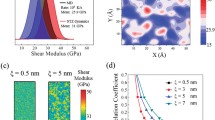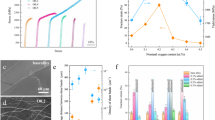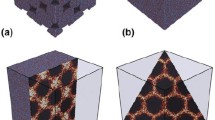Guo, H. et al. Tensile ductility and necking of metallic glass. Nat. Mater. 6, 735–739 (2007).
Article
ADS
CAS
PubMed
Google Scholar
Jang, D. & Greer, J. R. Transition from a strong-yet-brittle to a stronger-and-ductile state by size reduction of metallic glasses. Nat. Mater. 9, 215–219 (2010).
Article
ADS
CAS
PubMed
Google Scholar
Forrest, R. M. & Greer, A. L. Evolutionary design of machine-learning-predicted bulk metallic glasses. Digit. Discov. 2, 202 (2023).
Article
PubMed
PubMed Central
Google Scholar
Samavatian, M. et al. Characterization of nanoscale structural heterogeneity in metallic glasses: a machine learning study. J. Non-Cryst. Solids 578, 121344 (2022).
Article
CAS
Google Scholar
Wu, Y., Xu, B., Zhang, X. & Guan, P. Machine-learning inspired density-fluctuation model of local structural instability in metallic glasses. Acta Mater. 247, 118741 (2023).
Article
CAS
Google Scholar
Fan, Z., Ding, J. & Ma, E. Machine learning bridges local static structure with multiple properties in metallic glasses. Mater. Today 40, 48–62 (2020).
Article
CAS
Google Scholar
Sha, Z.-D., Branicio, P. S., Lee, H. P. & Tay, T. E. Strong and ductile nanolaminate composites combining metallic glasses and nanoglasses. Int. J. Plast. 90, 231–241 (2017).
Article
Google Scholar
Adibi, S. et al. A transition from localized shear banding to homogeneous superplastic flow in nanoglass. Appl. Phys. Lett. 103, 211905 (2013).
Article
ADS
Google Scholar
Hofmann, D. C. et al. Designing metallic glass matrix composites with high toughness and tensile ductility. Nature 451, 1085–1089 (2008).
Article
ADS
CAS
PubMed
Google Scholar
Wu, Y., **ao, Y., Chen, G., Liu, C. T. & Lu, Z. Bulk metallic glass composites with transformation-mediated work-hardening and ductility. Adv. Mater. 22, 2770–2773 (2010).
Article
CAS
PubMed
Google Scholar
Khalajhedayati, A., Pan, Z. & Rupert, T. J. Manipulating the interfacial structure of nanomaterials to achieve a unique combination of strength and ductility. Nat. Commun. 7, 10802 (2016).
Article
ADS
CAS
PubMed
PubMed Central
Google Scholar
Wu, G. et al. Hierarchical nanostructured aluminum alloy with ultrahigh strength and large plasticity. Nat. Commun. 10, 5099 (2019).
Article
ADS
PubMed
PubMed Central
Google Scholar
Ming, K. et al. Enhancing strength and ductility via crystalline-amorphous nanoarchitectures in TiZr-based alloys. Sci. Adv. 8, eabm2884 (2022).
Article
CAS
PubMed
PubMed Central
Google Scholar
Wang, W. H. Correlations between elastic moduli and properties in bulk metallic glasses. J. Appl. Phys. 99, 093506 (2006).
Article
ADS
Google Scholar
Kim, D., Kim, W., Park, E., Mattern, N. & Eckert, J. Phase separation in metallic glasses. Prog. Mater. Sci. 58, 1103–1172 (2013).
Article
CAS
Google Scholar
Chang, H. et al. Combinatorial synthesis and high throughput evaluation of ferroelectric/dielectric thin-film libraries for microwave applications. Appl. Phys. Lett. 72, 2185–2187 (1998).
Article
ADS
CAS
Google Scholar
Hanak, J. J. The “multiple-sample concept” in materials research: synthesis, compositional analysis and testing of entire multicomponent systems. J. Mater. Sci. 5, 964–971 (1970).
Article
ADS
CAS
Google Scholar
Yan, X. H., Li, J. S., Zhang, W. R. & Zhang, Y. A brief review of high-entropy films. Mater. Chem. Phys. 210, 12–19 (2018).
Article
CAS
Google Scholar
Li, M.-X. et al. High-temperature bulk metallic glasses developed by combinatorial methods. Nature 569, 99–103 (2019).
Article
ADS
CAS
PubMed
Google Scholar
Griesche, A., Macht, M.-P. & Frohberg, G. Chemical diffusion in bulk glass-forming Pd40Cu30Ni10P20 melts. Scr. Mater. 53, 1395–1400 (2005).
Article
CAS
Google Scholar
Takeuchi, A. & Inoue, A. Classification of bulk metallic glasses by atomic size difference, heat of mixing and period of constituent elements and its application to characterization of the main alloying element. Mater. Trans. 46, 2817–2829 (2005).
Article
CAS
Google Scholar
Wang, Y., Li, J., Hamza, A. V. & Barbee, T. W. Jr Ductile crystalline–amorphous nanolaminates. Proc. Natl Acad. Sci. USA 104, 11155–11160 (2007).
Article
ADS
CAS
PubMed
PubMed Central
Google Scholar
Shi, P. et al. Hierarchical crack buffering triples ductility in eutectic herringbone high-entropy alloys. Science 373, 912–918 (2021).
Article
ADS
CAS
PubMed
Google Scholar
Wu, G. et al. Symbiotic crystal-glass alloys via dynamic chemical partitioning. Mater. Today 51, 6–14 (2021).
Article
CAS
Google Scholar
Chen, Z., Holec, D., Bartosik, M., Mayrhofer, P. H. & Zhang, Z. Crystallographic orientation dependent maximum layer thickness of cubic AlN in CrN/AlN multilayers. Acta Mater. 168, 190–202 (2019).
Article
ADS
CAS
Google Scholar
Tian, L. et al. Approaching the ideal elastic limit of metallic glasses. Nat. Commun. 3, 609 (2012).
Article
ADS
PubMed
Google Scholar
Ye, J., Chu, J., Chen, Y., Wang, Q. & Yang, Y. Hardness, yield strength, and plastic flow in thin film metallic-glass. J. Appl. Phys. 112, 053516 (2012).
Article
ADS
Google Scholar
Wang, C.-C. et al. Sample size matters for Al88Fe7Gd5 metallic glass: smaller is stronger. Acta Mater. 60, 5370–5379 (2012).
Article
ADS
CAS
Google Scholar
Kuzmin, O., Pei, Y., Chen, C. & De Hosson, J. T. M. Intrinsic and extrinsic size effects in the deformation of metallic glass nanopillars. Acta Mater. 60, 889–898 (2012).
Article
ADS
CAS
Google Scholar
Wang, X. et al. Sample size effects on strength and deformation mechanism of Sc75Fe25 nanoglass and metallic glass. Scr. Mater. 116, 95–99 (2016).
Article
ADS
CAS
Google Scholar
Pan, J., Ivanov, Y. P., Zhou, W., Li, Y. & Greer, A. Strain-hardening and suppression of shear-banding in rejuvenated bulk metallic glass. Nature 578, 559–562 (2020).
Article
ADS
CAS
PubMed
Google Scholar
Bordeenithikasem, P. et al. Determination of critical cooling rates in metallic glass forming alloy libraries through laser spike annealing. Sci. Rep. 7, 1–9 (2017).
Article
CAS
Google Scholar
Chellali, M., Nandam, S. & Hahn, H. Deformation-induced chemical inhomogeneity and short-circuit diffusion in shear bands of a bulk metallic glass. Phys. Rev. Lett. 125, 205501 (2020).
Article
ADS
CAS
PubMed
Google Scholar
Balachandran, S. et al. Elemental re-distribution inside shear bands revealed by correlative atom-probe tomography and electron microscopy in a deformed metallic glass. Scr. Mater. 168, 14–18 (2019).
Article
CAS
Google Scholar
Tung, P.-Y., Zhou, X., Mayweg, D., Morsdorf, L. & Herbig, M. Under-stoichiometric cementite in decomposing binary Fe-C pearlite exposed to rolling contact fatigue. Acta Mater. 216, 117144 (2021).
Article
CAS
Google Scholar
Li, Y. et al. Atomic-scale mechanisms of deformation-induced cementite decomposition in pearlite. Acta Mater. 59, 3965–3977 (2011).
Article
ADS
CAS
Google Scholar
Spaepen, F. A microscopic mechanism for steady state inhomogeneous flow in metallic glasses. Acta Metall. 25, 407–415 (1977).
Article
CAS
Google Scholar
Zhang, Z., Ding, J. & Ma, E. Shear transformations in metallic glasses without excessive and predefinable defects. Proc. Natl Acad. Sci. USA 119, e2213941119 (2022).
Article
CAS
PubMed
PubMed Central
Google Scholar
Chen, C. Q. et al. Intrinsic size effects in the mechanical response of taper-free nanopillars of metallic glass. Phys. Rev. B 83, 180201 (2011).
Article
ADS
Google Scholar
Zhu, Y. & Wu, X. Perspective on hetero-deformation induced (HDI) hardening and back stress. Mater. Res. Lett. 7, 393–398 (2019).
Article
Google Scholar
Guo, W. et al. Intrinsic and extrinsic size effects in the deformation of amorphous CuZr/nanocrystalline Cu nanolaminates. Acta Mater. 80, 94–106 (2014).
Article
CAS
Google Scholar
Huang, L. et al. A high-strength Co–Fe–Ta–B metallic-glass phase enabled tensile plasticity in Co–Fe–Ta–B–O oxide glass matrix nanocomposites. Appl. Phys. Lett. 116, 081903 (2020).
Article
ADS
CAS
Google Scholar
Ketov, S. et al. Rejuvenation of metallic glasses by non-affine thermal strain. Nature 524, 200–203 (2015).
Article
ADS
CAS
PubMed
Google Scholar
Wu, Y. et al. Substantially enhanced plasticity of bulk metallic glasses by densifying local atomic packing. Nat. Commun. 12, 6582 (2021).
Article
ADS
CAS
PubMed
PubMed Central
Google Scholar
Liu, Y. H. et al. Super plastic bulk metallic glasses at room temperature. Science 315, 1385–1388 (2007).
Article
ADS
CAS
PubMed
Google Scholar
Pauly, S., Gorantla, S., Wang, G., Kühn, U. & Eckert, J. Transformation-mediated ductility in CuZr-based bulk metallic glasses. Nat. Mater. 9, 473–477 (2010).
Article
ADS
CAS
PubMed
Google Scholar








